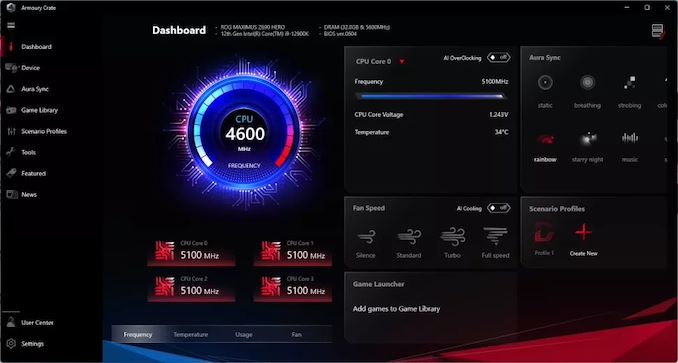The ASUS ROG Maximus Z690 Hero Motherboard Review: A Solid Option For Alder Lake
by Gavin Bonshor on June 15, 2022 8:00 AM EST- Posted in
- Motherboards
- Intel
- Asus
- ROG
- DDR5
- PCIe 5.0
- Alder Lake
- 12th Gen Core
- Z690
- LGA1700
BIOS
For the Z690 chipset, ASUS has kept the GUI the same as previous iterations of its ROG and Intel-based motherboards. It uses a red and black background at the top, with a dark grey main panel with white text and a red highlighting when mousing or selecting over a specific option. ASUS includes two modes in the BIOS, the EZ Mode for a basic overview of information and installed hardware, and the Advanced section, which opens up all of the board's customizable options, including overclocking and chipset related options.
The most prominent section within the Advanced area of the firmware is the Extreme Tweaker area. In this section, users can overclock the Performance (P) cores, the Efficiency (E) cores, the memory, and the integrated graphics. There are extensive options for all three main areas for users to overclock, including an extensive array of customizable memory latencies for fine-tuning. In addition to this, the ROG Maximus series also has a wider variety of voltage control options for CPU, memory, System Agent, and SoC than ASUS's cheaper boards.
ASUS even includes a hardware monitor, a fan tuning section within the BIOS, and easy quick links to various sections of firmware along the top. This includes ASUS AURA for customizing the integrated RGB LED lighting, ASUS's AI OC guide, Resizeable BAR, and integrated MemTest86 software for diagnosing memory issues.
Overall, the ASUS ROG firmware is intuitive, stylish, and most importantly, easy to navigate and has lots of customizable options. As we typically see with premium motherboards such as ASUS's ROG Maximus series, there are usually more overclocking options and finer control over voltages for those enthusiasts that like to push the limits. Users looking for a plug and play or those looking to tweak will find plenty of functionality within the ROG Maximus Z690 Hero firmware.
Software
Most ASUS's software bundle revolves around two main applications, the ROG Armory Crate and the Ai Suite 3 software. Upon setting up a system for the first time, ROG Armory Crate allows users to install critical updates such as networking and chipset drivers directly from a pool of designated memory on the board to get things up and running.
Not only does the Armory Crate allow users to keep drivers and software up-to-date, but it has a range of functions, including ASUS AURA Sync, fan speed control, as well as one-click access to ASUS's AI automatic overclocking.
The AI Suite 3 software has a more in-depth variety of settings that allow users to customize power delivery profiles and apply power efficiency states and software overclocking. With the new technology on Intel's Alder Lake, when used in conjunction with Intel's Extreme Tuning Utility (XTU), users can also apply Intel's one-click overclocking function. We prefer their more aggressive profiling regarding ASUS as the firmware has a look-up table with certain variables for more performance. However, this will generate more heat and power consumption.
Overall, ASUS's software tools provide many avenues to customize things such as RGB LED lighting, make auditory adjustments via Sonic Studio and the Realtek Audio applications, and control fan speeds. It's a more well-rounded selection of software with fewer apps but more functionality.
























40 Comments
View All Comments
PlextorPro - Thursday, June 16, 2022 - link
Seriously, thank you for this review and in-depth evaluation!With the recent increase in popularity of MINI-ITX (SFF) systems, I would like to see an in-depth! review-comparison of the ASUS ROG Strix Z690-I with other MINI-ITX main boards. I have built a system with this MINI-ITX MB and am very pleased with the performance.
It has a custom loop for cooling both the i9 12900K and an AMD RX 6800 GPU.
Dr_b_ - Friday, June 17, 2022 - link
Do people actually want all the bling on the motherboard like the plastic LED features, which imho are really not appealing, and all the metal armor? It doesn't make it go faster, and adds cost. This is a retail value $490 mobo, selling for $600. With Z790 mobos due out in a few months, unless completely desperate and flush with cash, makes no sense to buy it.COtech - Sunday, June 19, 2022 - link
Hopefully Z790 boards will come with a "downturn mindset" - function not flash. Otherwise I don't see them selling.poohbear - Wednesday, June 22, 2022 - link
These $600 mobos are $250-$300 in a year's time. Don't pay this early adopter tax.mode_13h - Thursday, June 23, 2022 - link
I was just looking at ASUS boards, the other day. I've somewhat unexpectedly found myself pondering an upgrade of my workstation to Alder Lake. I visited ASUS' site and found their product filter to be half-broken (when I select ATX form factor, why am I still being shown mini-ITX boards??) and couldn't make very much sense of their different product lines.bwj - Monday, June 27, 2022 - link
Any mobo with the i7-12700K will hit 5100MHz without any tuning whatsoever, 5200MHz if you remove all the power limits and don't touch anything else. What you get from +$200 for the i9 CPU and +$450 on the mobo is an extra 100MHz? Hardly seems like money well spent.The only real argument I can see for this board is it comes with the thunderbolt ports and the 2.5G ethernet, instead of requiring the $130 (and terrible) TB4 add-in card and the $75 i225v add-in card.
NickFisherUX - Wednesday, August 10, 2022 - link
ASUS has always made the best boards.